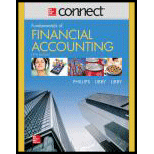
Connect 1 Semester Access Card for Fundamentals of Financial Accounting
5th Edition
ISBN: 9781259128547
Author: Fred Phillips Associate Professor, Robert Libby, Patricia Libby
Publisher: McGraw-Hill Education
expand_more
expand_more
format_list_bulleted
Question
Chapter 6, Problem 7MC
To determine
The meaning of sales discounts with terms 2/10, n/30.
Expert Solution & Answer
Want to see the full answer?
Check out a sample textbook solution
Students have asked these similar questions
Olivia, single and age 58, sold her home for $485,000 after living there for 10 years. Her selling expenses were $9,000 and her adjusted basis in the home was $200,000. What is the maximum gain that Olivia must report in connection with the sale of her principal residence?
Hello tutor please given General accounting question answer do fast and properly explain all answer
Please explain the correct approach for solving this general accounting question.
Chapter 6 Solutions
Connect 1 Semester Access Card for Fundamentals of Financial Accounting
Ch. 6 - Prob. 1QCh. 6 - If a Chicago-based company ships goods on...Ch. 6 - Define goods available for sale. How does it...Ch. 6 - Define beginning inventory and ending inventory.Ch. 6 - Describe how transportation costs to obtain...Ch. 6 - What is the main distinction between perpetual and...Ch. 6 - Why is a physical count of inventory necessary in...Ch. 6 - What is the difference between FOB shipping point...Ch. 6 - Describe in words the journal entries that are...Ch. 6 - What is the distinction between Sales Returns and...
Ch. 6 - Prob. 11QCh. 6 - In response to the weak economy, your companys...Ch. 6 - Prob. 13QCh. 6 - Why are contra-revenue accounts used rather than...Ch. 6 - What is gross profit? How is the gross profit...Ch. 6 - Prob. 1MCCh. 6 - Prob. 2MCCh. 6 - Prob. 3MCCh. 6 - Prob. 4MCCh. 6 - Prob. 5MCCh. 6 - Prob. 6MCCh. 6 - Prob. 7MCCh. 6 - Prob. 8MCCh. 6 - Prob. 9MCCh. 6 - Prob. 10MCCh. 6 - Distinguishing among Operating Cycles Identify the...Ch. 6 - Calculating Shrinkage in a Perpetual Inventory...Ch. 6 - Prob. 6.3MECh. 6 - Inferring Purchases Using the Cost of Goods Sold...Ch. 6 - Evaluating Inventory Cost Components Assume...Ch. 6 - Prob. 6.6MECh. 6 - Recording Journal Entries for Purchases and Safes...Ch. 6 - Prob. 6.8MECh. 6 - Recording Journal Entries for Sales and Sales...Ch. 6 - Prob. 6.10MECh. 6 - Prob. 6.11MECh. 6 - Calculating Shrinkage and Gross Profit in a...Ch. 6 - Preparing a Multistep Income Statement Sellall...Ch. 6 - Prob. 6.14MECh. 6 - Computing and Interpreting the Gross Profit...Ch. 6 - Interpreting Changes in Gross Profit Percentage...Ch. 6 - Prob. 6.17MECh. 6 - Understanding Relationships among Gross Profit and...Ch. 6 - Relating Financial Statement Reporting to Type of...Ch. 6 - Prob. 6.2ECh. 6 - Identifying Shrinkage and Other Missing inventory...Ch. 6 - Prob. 6.4ECh. 6 - Prob. 6.5ECh. 6 - Inferring Missing Amounts Based on Income...Ch. 6 - Prob. 6.7ECh. 6 - Prob. 6.8ECh. 6 - Reporting Purchases, Purchase Discounts, and...Ch. 6 - Prob. 6.10ECh. 6 - Items Included in Inventory PC Mall, Inc., is a...Ch. 6 - Prob. 6.12ECh. 6 - Prob. 6.13ECh. 6 - Reporting Net Sales with Credit Sales and Sales...Ch. 6 - Prob. 6.15ECh. 6 - Prob. 6.16ECh. 6 - Prob. 6.17ECh. 6 - Determining the Effects of Credit Sales, Sales...Ch. 6 - Prob. 6.19ECh. 6 - Inferring Missing Amounts Based on Income...Ch. 6 - Prob. 6.21ECh. 6 - Prob. 6.22ECh. 6 - (Supplement 6A) Recording Purchases and Sales...Ch. 6 - Prob. 6.1CPCh. 6 - Prob. 6.2CPCh. 6 - Prob. 6.3CPCh. 6 - Prob. 6.4CPCh. 6 - (Supplement A) Recording Inventory Transactions...Ch. 6 - Prob. 6.1PACh. 6 - Reporting Purchase Transactions between Wholesale...Ch. 6 - Recording Sales with Discounts and Returns and...Ch. 6 - Prob. 6.4PACh. 6 - (Supplement A) Recording Inventory Transactions...Ch. 6 - Prob. 6.1PBCh. 6 - Reporting Purchase Transactions between Wholesale...Ch. 6 - Prob. 6.3PBCh. 6 - Prob. 6.4PBCh. 6 - (Supplement A) Recording Inventory Transactions...Ch. 6 - Accounting for Inventory Orders, Purchases, Sales,...Ch. 6 - Prob. 6.1SDCCh. 6 - Prob. 6.2SDCCh. 6 - Internet-Based Team Research: Examining an Annual...Ch. 6 - Evaluating the Results of Merchandising Operations...Ch. 6 - Prob. 6.6SDCCh. 6 - Prob. 6.1CC
Knowledge Booster
Similar questions
- I need guidance in solving this financial accounting problem using standard procedures.arrow_forwardI need guidance with this financial accounting problem using the right financial principles.arrow_forwardI need guidance with this financial accounting problem using the right financial principles.arrow_forward
- TOSHIBA ended the year with an inventory of $842,000. During the year, the firm purchased $5,467,000 of new inventory and the cost of goods sold reported on the income statement was $5,215,000. What was TOSHIBA's inventory at the beginning of the year?arrow_forwardCan you solve this general accounting question with accurate accounting calculations?arrow_forwardOn January 1, 2011, Phoenix Manufacturing purchased for $875,000, equipment having a useful life of eight years and an estimated salvage value of $67,500. Phoenix has recorded monthly depreciation of the equipment on the straight-line method. On December 31, 2018, the equipment was sold for $158,000. As a result of this sale, Phoenix Manufacturing should recognize a gain of___. Help me with thisarrow_forward
arrow_back_ios
SEE MORE QUESTIONS
arrow_forward_ios
Recommended textbooks for you
 Intermediate Financial Management (MindTap Course...FinanceISBN:9781337395083Author:Eugene F. Brigham, Phillip R. DavesPublisher:Cengage Learning
Intermediate Financial Management (MindTap Course...FinanceISBN:9781337395083Author:Eugene F. Brigham, Phillip R. DavesPublisher:Cengage Learning EBK CONTEMPORARY FINANCIAL MANAGEMENTFinanceISBN:9781337514835Author:MOYERPublisher:CENGAGE LEARNING - CONSIGNMENT
EBK CONTEMPORARY FINANCIAL MANAGEMENTFinanceISBN:9781337514835Author:MOYERPublisher:CENGAGE LEARNING - CONSIGNMENT

Intermediate Financial Management (MindTap Course...
Finance
ISBN:9781337395083
Author:Eugene F. Brigham, Phillip R. Daves
Publisher:Cengage Learning

EBK CONTEMPORARY FINANCIAL MANAGEMENT
Finance
ISBN:9781337514835
Author:MOYER
Publisher:CENGAGE LEARNING - CONSIGNMENT

